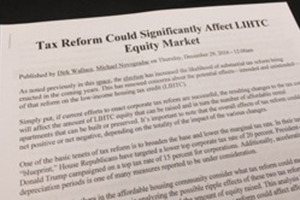All eyes and ears were focused on the panelists for last week’s 2017 Housing Credit Program Outlook plenary session at the National Council of State Housing Agencies’ (NCSHA’s) HFA Institute.
For the last three or four years, attendees had heard speakers touch on the topic of tax reform, how likely it was (or wasn’t), what impact it may have on the Low Income Housing Tax Credit (LIHTC) industry, and the continued need to lobby support for the program.
Fast-forward 12 months from NSCHA’s 2016 HFA Institute and we are facing a whole new ballgame. Robert Rozen, policy consultant with R Rozen Associates, put it this way: “Up until now we’ve been playing regular season games. Now it’s the playoffs. We must be prepared to win this game.”

Tax reform is now a reality, and it will have an impact on the LIHTC program.
So…When will it happen? What will it include/exclude? What will the impact be? How do we handle it? Will the program survive? These are all questions being asked, but unfortunately the one common answer and the one common theme is…uncertainty. Let’s take these questions one by one:
When will tax reform happen?
The panelists’ best guess is that the House and Senate develop some sort of tax bill this summer, which would lead to conference next fall.
What will reform include/exclude?
Formulating a tax bill will not happen overnight and as to what the final product will look like will be anybody’s guess. According to Robert Moss, principal and national director of governmental affairs with CohnReznick LLP, the House Ways and Means Republicans recently held a retreat to figure out what elements would be included in their tax blueprint.
During this retreat, it is said that a voice vote was held to keep the LIHTC program as part of the plan. Fingers crossed! What was not addressed, however, was whether or not private activity bonds would be continued as part of tax reform. Scott Hoekman, senior vice president and chief credit officer for Enterprise Community Investment, said this is an unsettling thought, given that the use of tax-exempt bonds accounts for 40 percent of production through the tax credit program.
What does appear to be certain is an adjustment to the corporate tax rate. Currently corporations are taxed at 35 percent, however, President-elect Trump has proposed reducing the corporate tax rate down to 15 percent. While all panelists agreed that 15 percent was unlikely, where actual tax rates may end up remains to be seen. Most industry experts and investors are assuming a middle ground of 20 to 25 percent.
What impact will this have?
The better question is, “What impact is this having?” because it’s already having an impact. The prospects of tax reform and conversations over a lower corporate tax rate have shaken the LIHTC equity markets.

As a developer, unless you have a deal that closed in October or November 2016 or were “locked in” to a syndicator’s closed fund, you have without a doubt received a call from your investor letting you know that your equity pricing is going to drop.
To keep it simple, a 10-15 percent drop in corporate tax rates will likely translate into a $0.10 to $0.15 drop in equity pricing.
Various other aspects of tax reform could give rise to additional adjustments in the equity markets. Michael Novogradac, managing partner with Novogradac & Company LLP, touched on a few of those during the plenary session, including rises to interest rates, interest expense deductions, accelerated depreciation periods, etc.
For a more detailed analysis, refer to this article published in December by Dirk Wallace and Michael Novogradac of Novogradac & Company LLP: https://www.novoco.com/notes-from-novogradac/tax-reform-could-significantly-affect-lihtc-equity-market
While there’s definitely been a shake-up in the equity markets as syndicators and investors adjust to the prospects of reform, it must be noted that this shake-up does not parallel the disruption experienced in the markets in 2008/2009 when investors backed away from the market entirely.
Today demand for the tax credit remains strong, and while pricing is decreasing, it is not a result of investors backing away from the market and the value of the credit being diminished.
How does the industry handle the shake-up?
The panelists hinted at both an immediate and near-term approach. Right now the immediate need is addressing projects that received 2016 credit allocations and were unable to close before the end of the year.
These are the projects that are in the greatest jeopardy and are now likely faced with a $500,000 – $1.5 million financing gap due to reduced equity pricing. Beth Stohr (U.S. Bancorp Community Development Corporation) and Eileen Fitzgerald (Stewards of Affordable Housing for the Future) both acknowledged that some deals simply will not survive, but those that do will likely do so by “sharing the pain” with a combination of investors structuring the deals with thinner margins, developers deferring additional developer fee, and more intensive value engineering.
Obviously no one wants a deal to fail, so a request was made to each state housing agency to consider efforts to help preserve projects. Some suggestions offered included: providing additional credits, providing soft funds to fill the gap, and waiving certain development and design requirements.
In the near-term, meaning 2017 applications, deal structure and timing will be very important.
The veil of uncertainty will loom well into midyear, resulting in syndicators having to make assumptions for how new investment funds will be structured. By the end of the first quarter, most syndicators will have investor guidance on how they will proceed in 2017.
Developers should assume rising interest rates and lower equity pricing. LOIs and Partnership Agreements will now include adjuster language to account for corporate tax rate fluctuations. Construction costs will continue to rise. Competition for the housing credit and soft funding sources will be as competitive as ever, but deals will continue to get done.
Will the LIHTC program survive?
This is the million dollar question. All of the panelists indicated that “yes,” the LIHTC program will survive tax reform, but we simply cannot sit back and watch as reform unfolds.
With the new incoming administration and a Republican-controlled House and Senate, we must be as aggressive as ever in terms of lobbying your representatives and Congress for support — and expansion — of the program.
Just prior to NCSHA’s conference, Barbara Thompson, executive director of NCSHA, received a call from Dr. Ben Carson (President-elect Trump’s nominee for HUD secretary). Ms. Thompson reported that Dr. Carson was aware of both NCSHA and the LIHTC program and that he very much liked the public-private partnership created by the program.
So how will 2017 play out? Well to keep Robert Rozen’s sports analogy alive, it looks as though all player introductions have been made and the teams are ready to take the field….batter up!
Get involved! Read this blog post on how you can help advocate for tax credit programs: https://travois.com/action-needed-behalf-lihtc-nmtc-indian-country/


